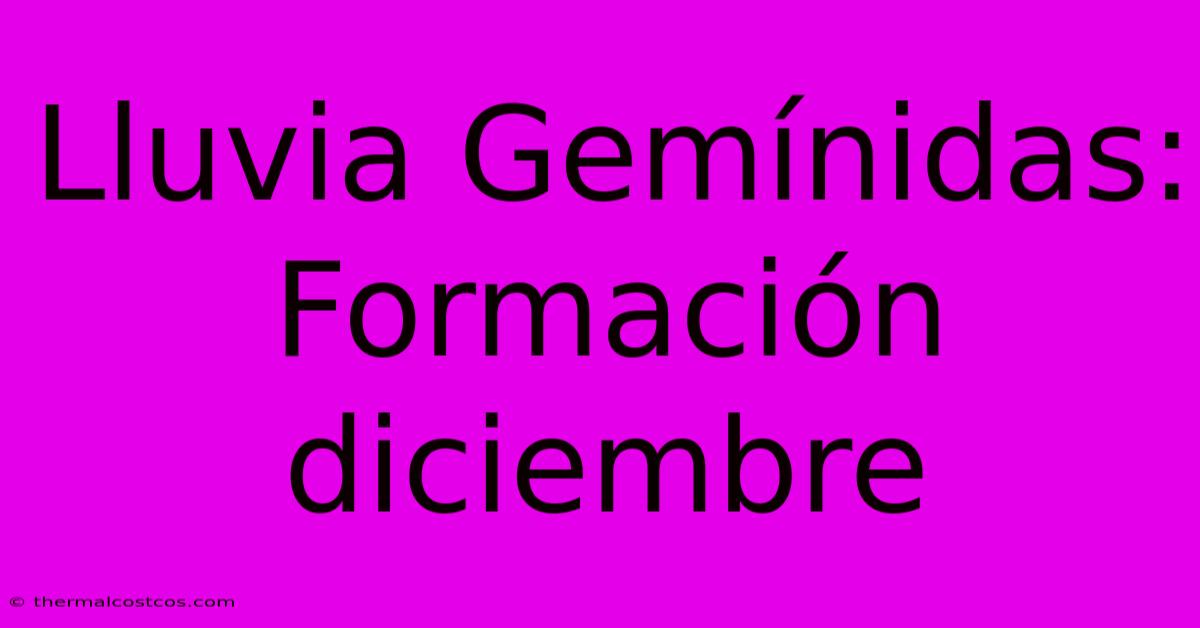Lluvia Gemínidas: Formación Diciembre

Discover more detailed and exciting information on our website. Click the link below to start your adventure: Visit Best Website a7d4ae423c.kloo.eu.org/a58ea7. Don't miss out!
Discover more detailed and exciting information on our website. Click the link below to start your adventure: Visit Best Website mr.cleine.com. Don't miss out!
Table of Contents
Lluvia de Gemínidas: Formación y Espectáculo de Diciembre
The Geminid meteor shower, a celestial spectacle visible every December, is a truly remarkable event. But what is its formation, and what makes it so special? Let's delve into the science and wonder behind this annual display.
Understanding the Geminids: More Than Just "Shooting Stars"
Unlike many meteor showers originating from comets, the Geminids' source is rather unique: 3200 Phaethon, an asteroid. This near-Earth object, classified as a potentially hazardous asteroid, is believed to be the parent body of the Geminid meteoroid stream. The precise nature of 3200 Phaethon is still debated amongst scientists; some suggest it's an extinct comet, while others classify it as a rocky asteroid. This ambiguity adds to the Geminids' intrigue.
The Formation of the Geminid Meteoroid Stream: Dust and Debris
As 3200 Phaethon orbits the sun, it sheds debris. This debris, ranging in size from tiny dust particles to larger pebbles, forms a trail along its orbital path. This trail isn't uniformly distributed; it's clumpy and concentrated in certain areas. This clumpiness contributes to the variations in intensity observed from year to year in the Geminid meteor shower.
The Earth, in its annual journey around the sun, intersects this debris trail. When these particles enter Earth's atmosphere at incredibly high speeds, they burn up, creating the dazzling streaks of light we see as meteors. The radiant point – the apparent origin of the meteors – is located in the constellation Gemini, hence the name "Geminids."
The December Display: Peak Activity and Viewing
The Geminid meteor shower typically peaks in mid-December, usually around December 13th or 14th. During this peak, observers under dark skies can witness dozens, even hundreds, of meteors per hour. The shower's high rate of meteors and its relatively bright trails contribute to its popularity among amateur astronomers and stargazers.
Factors influencing viewing:
- Dark skies: Light pollution significantly reduces visibility. Getting away from city lights is crucial for optimal viewing.
- Moon phase: A bright moon can wash out fainter meteors. Years with a new moon or a crescent moon during the peak provide the best viewing conditions.
- Weather: Clear skies are essential. Cloud cover will completely obscure the shower.
Why are the Geminids so Special?
Several factors make the Geminids stand out:
- High meteor rate: Its exceptionally high zenithal hourly rate (ZHR) often surpasses 100 meteors per hour.
- Bright and colorful meteors: Many Geminid meteors leave bright, persistent trails across the night sky, often exhibiting vibrant colors.
- Asteroid origin: Unlike most meteor showers originating from comets, its link to an asteroid adds a layer of scientific intrigue.
Observing the Geminids: Tips for a Memorable Experience
To make the most of your Geminid viewing experience:
- Find a dark location: Get away from city lights for the best views.
- Bring a blanket or reclining chair: You'll be looking upwards for extended periods.
- Be patient: The meteors appear sporadically, so allow your eyes to adapt to the darkness.
- Dress warmly: December nights can be cold.
The Geminid meteor shower is a spectacular celestial event, combining scientific wonder with breathtaking visual beauty. Its unique origin and impressive display make it a must-see for anyone interested in astronomy. So, mark your calendar for mid-December and prepare to witness the dazzling fireworks of the Geminids!

Thank you for visiting our website wich cover about Lluvia Gemínidas: Formación Diciembre. We hope the information provided has been useful to you. Feel free to contact us if you have any questions or need further assistance. See you next time and dont miss to bookmark.
Featured Posts
-
Vestingcross Hulst Van Der Poel Absent
Dec 14, 2024
-
Cybercrime Metagrow Loses Its License
Dec 14, 2024
-
Incendio Activa Alerta Roja En Lampa
Dec 14, 2024
-
Mom Awards A Night For National Athletes
Dec 14, 2024
-
Allsvensk Debutant Foerstaerker Bois
Dec 14, 2024
